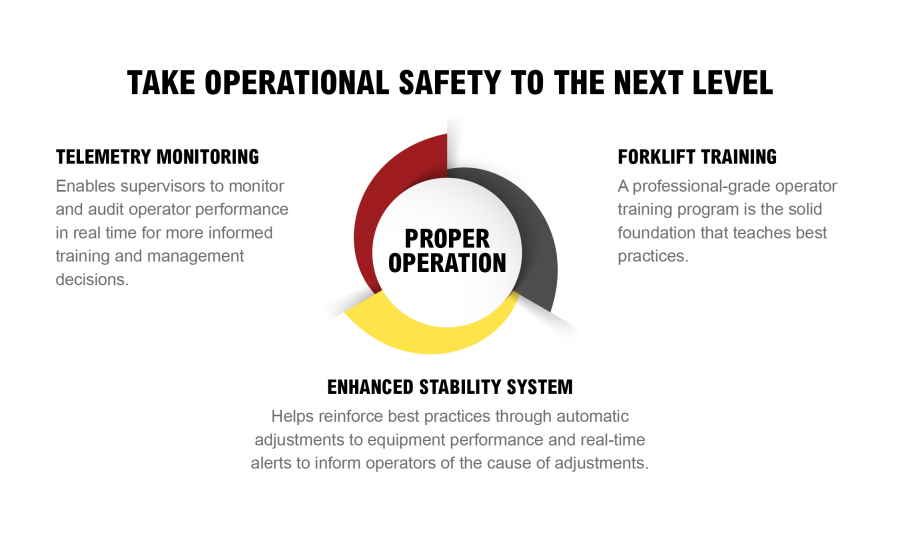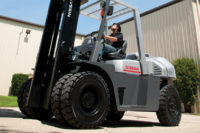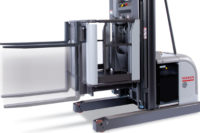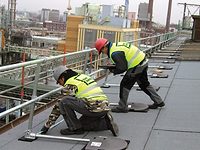Is your operation doing enough to support lift truck operating best practices? There’s no silver bullet here — forklift safety requires a multi-faceted approach, including training, real-time support and monitoring, and retroactive evaluation. Those elements must also evolve over time to keep pace with technology. This article explores how lift truck operations can leverage a comprehensive forklift safety strategy.
Training: Build a Strong Foundation
Operator training is foundational to forklift safety. The Occupational Safety and Health Administration requires lift truck operators to receive formal instruction and training in using equipment at their job site. No two operations are the same, so it is critical to strategize a training process tailored to your needs.
Technology-enabled options may be worth considering for facilities frequently onboarding new operators. Human delivery of information can naturally result in some variance — from instructor to instructor or session to session. A training format that leverages packaged digital material can help minimize inconsistencies and leverage contemporary adult learning methodologies to help keep trainees engaged. Technology can also help support operator training through immersive simulation. While not a replacement for hands-on training, virtual reality simulators can help reduce training liabilities while allowing operators to familiarize themselves with new equipment and environments.
Telemetry: Monitor Operator Performance in Real Time
Telemetry Tailored to Operator Development
- Restricts equipment access to operators with proper truck certification
- Controls who can start equipment through individual access cards with certification information encoded
- Provides automatic notifications when operator certifications are close to expiring
Telemetry systems track several aspects of a fleet, from equipment use and diagnostics to individual operator performance. This information can be digitally accessed in real-time to help operations make informed decisions and manage operator behavior. Tracking at the specific truck and operator level allows visibility to information like travel locations and idle time. Some systems even can provide managers with information when impacts occur. Data can also be used to help identify high performers who deserve recognition and operators who may require more training.
Operator Assist Systems (OAS): Support Your Operators
While telemetry can help facilities monitor and retroactively address operator behavior and truck impacts, other operator-assist systems offer a more proactive approach to help minimize risks and reinforce safe operating practices.
For example, the Dynamic Stability System from Hyster promotes lift truck stability by applying limitations to truck performance in certain conditions, accompanied by audible and visual alerts that communicate the cause of the intervention to the operator. These automatic interventions happen in real-time, helping to support stable travel and providing operators with an immediate layer of feedback that can help reinforce the proper lift truck operation established during their training.
This technology is made up of four sub-systems:
- Lateral stability reduces truck lean in turns to help reduce the likelihood of sideways tip overs.
- High-lift tilt control limits tilt speed and forward tilt range when carriage is raised above height threshold while carrying a load.
- High-lift traction control limits truck speed when handling elevated load if carriage is raised above height threshold.
- Corner control dynamically limits speed when driving around corners, based on how tightly the truck is turning.
Stability control in action
Heavy loads, tough environments — safety is critical in materials handling. Stability systems assist operators in real time while keeping them in command of the truck. Picture this:
- An operator retrieves a load stored at height. When they back up and move while lowering the load, the system automatically prevents them from driving too quickly and limits forward tilt to support stability.
- As the operator travels, the system limits speed based on how tightly the truck turns, while working to reduce truck lean.
- Audible alerts and visual indicators supplement the noticeable feedback from performance reductions to let operators know the system is intervening with real-time input.






Report Abusive Comment